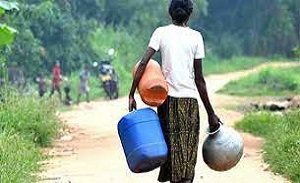Sri Lanka risks water crisis

Colombo (AsiaNews) - The risk of a water crisis is growing in Sri Lanka due to the dry climate experienced in recent weeks. While the population has started to consume more water on the advice of health officials, the National Water Supply and Drainage Board has urged them to use the resource sparingly because, according to the meteorology department, rainfall could last until May this year. year.
Several local authorities have requested the construction of wells to tap groundwater. Some areas, such as Gampaha and Kalutara in the Western Province, and Kilinochchi and Mullaitivu in the Northern Province, are already facing water shortages.
According to Neil Leelarathna, coordinator of the Water Supply Professionals Trade Union Alliance, “Sri Lanka is struggling to manage its water resources with increasing demand for water for electricity generation, agriculture and drinking purposes. This is why it is necessary to use water sparingly."
Climatologists Dinusha Wijeratna and Sajith Tennakoon, currently living in Australia, explained to AsiaNews that "between 2016 and 2017, when El Niño hit Sri Lanka, over two million people were affected by a drought, with 19 districts out of 25 in serious pain. Two harvest seasons had been lost. Due to the impact of El Niño in late 2023 in the Asia-Pacific region, in Sri Lanka the consequences will be felt from January to May this year, and will have a direct impact on communities."
“About 35.6% of Sri Lankans - the experts continued - are vulnerable to water scarcity, which aggravates the impact of this multi-faceted crisis. According to forecasts by the FAO and the United Nations World Food Programme, the drought will increase food insecurity towards the latter part of the year."
Academics Sampath Malalasekera and Nishantha Senanayaka argue that “water is at the heart of the way of life in Sri Lanka, where villages and communities have developed around water sources. In most rural areas, water-related civilizations have flourished with efficient and equitable methods of managing the resources on which communities and livelihoods depended. Instead today about a third of the population is vulnerable to water scarcity, particularly those who live in the dry zone."
Sri Lanka ranks very high on the global climate risk index. According to FAO data, Sri Lanka is currently subjected to 90.8% water stress: this means that water consumption is equal to 90.8% of available freshwater resources.
According to officials of the National Water Supply and Drainage Board, last year, “water was distributed to 55,000 families in 52 areas of the Divisional Secretariat due to dry weather. Similarly, this year too, several provinces will be negatively affected and people may have to travel long distances in search of water for cooking and drinking."
As water levels have fallen, particularly those in the Kelaniya and Kalu Ganga rivers, water quality has also worsened, experts further point out, because seawater enters and increases the salinity of the river water. Additionally, when water levels drop, sediments begin to build up in reservoirs and mix with drinking water leading to health problems.
By Arundathie Abeysinghe
Source: https://www.asianews.it/news-en

